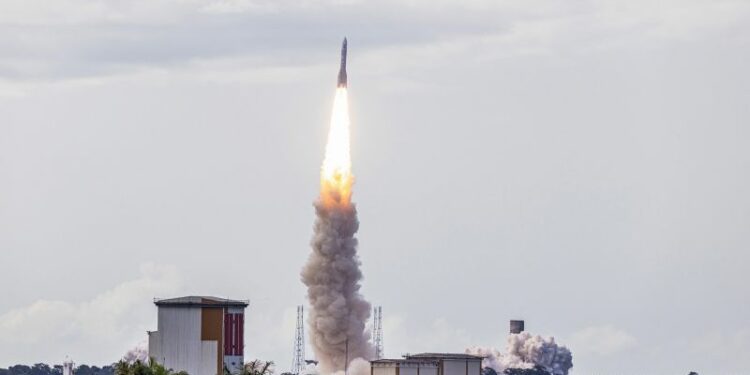Sign up for CNNŌĆÖs Wonder Theory science newsletter.┬ĀExplore the universe with news on fascinating discoveries, scientific advancements and more.
CNN
┬ĀŌĆö┬Ā
The European Space AgencyŌĆÖs member countries have endured a months-long space access predicament while waiting to add a functioning launch vehicle to their toolbox.
But a new rocket, dubbed Ariane 6, just launched on its maiden mission after years of delays and hang-ups in the development process.
The flight kicked off at Guiana Space Center in Kourou, French Guiana, which lies along South AmericaŌĆÖs northern tip, at 3 p.m. ET. And it appeared to go through most of its milestones without a hitch, propelling itself through orbit. Cheers rang out in the control room as the Ariane 6 strolled through milestones, including deploying its first satellites.
However, around 2 hours and 50 minutes into the flight, before the Ariane 6 upper rocket booster dove back toward Earth, intentionally plunging out of orbit, officials announced that an ŌĆ£anomalyŌĆØ ŌĆö aerospace parlance for something gone awry ŌĆö occurred. The root cause of the issue was not immediately clear.
An engineŌĆÖs reignition stopped prematurely. That prevented the rocket from finishing its mission as expected.
Though TuesdayŌĆÖs mission didnŌĆÖt go entirely as planned, the space agency hopes the Ariane 6 rocket system will go on to make the space agency more self-reliant and even challenge SpaceXŌĆÖs dominance in the global market for launching satellites.
France-based launch service provider Arianespace is the operator of Ariane 6. The aerospace firm was founded in 1980 and is billed as the ŌĆ£the worldŌĆÖs first commercial space transportation company.ŌĆØ Arianespace is part of ArianeGroup, a joint venture between Airbus and Safran that developed and built the powerful rocket.
But the European launch industry has struggled in recent years. The Ariane 6ŌĆÖs predecessor, Ariane 5, flew its final voyage in July 2023, ending the rocketŌĆÖs 27-year run. EuropeŌĆÖs┬ĀVega-C rocket, designed for vaulting small satellites to orbit, has also been grounded since a December 2022 failure.
The commercial launch market, for the record, is far different than it was even two decades ago ŌĆö mostly due to Elon MuskŌĆÖs California-based company SpaceX and its relatively affordable Falcon rockets.
Now, ESA is aiming to bounce back, and ŌĆö even if itŌĆÖs unable to compete directly with SpaceX on price ŌĆö capture more of the European market.
Already, however, there are setbacks.
Josef Aschbacher, the ESAŌĆÖs director general, has openly criticized The European Organisation for the Exploitation of Meteorological Satellites, or EUMETSAT, for choosing to launch a weather satellite on a SpaceX-built Falcon 9 rocket rather than on Ariane 6.
ŌĆ£ItŌĆÖs difficult to understand,ŌĆØ Aschbacher said in a social media post that appeared on X, formerly known as Twitter. ŌĆ£The end of the launcher is within reach. Now is the time for Europe to support autonomous access to space, which is on the horizon.ŌĆØ
Still, Ariane 6 has already inked some high-profile contracts, including plans to launch some of AmazonŌĆÖs new constellation of internet-beaming satellites.
Officials from Arianespace, Ariane Group and ESA all celebrated TuesdayŌĆÖs launch, declaring that Europe was officially back in space.
Similar to the Ariane 5 rocket, the latest iteration of this launch system hopes to offer the capability of hauling fairly large satellites to orbit at a reasonable price.
However, itŌĆÖs not yet clear how much the rocket will ultimately cost per launch. The vehicle cost about 4 billion euros ($432.5 billion USD) to develop, and officials have indicated they hope the per-launch cost will be well under $100 million. In comparison, SpaceXŌĆÖs Falcon 9 rocket has a base price of $67 million and can carry slightly more tonnage into low-Earth orbit.

On Tuesday, the rocket took off on its inaugural test flight hauling small satellites, experiments and technology demonstrations.
The mission plan for the rocket was to reignite the engine that powers the upper part of the rocket twice, practicing its ability to make multiple stops in orbit. The engine relit just once before the anomaly, successfully deploying some of its payloads.
The rocketŌĆÖs upper stage was then expected to intentionally dive back toward Earth to and sink to a watery grave in the ocean near Point Nemo ŌĆö a spot in the Pacific Ocean farther from land than any place on Earth. At the same time, two experimental capsules were supposed be jettisoned and attempt to survive the trip home. The mission ended before those events occurred.
Source link : http://www.bing.com/news/apiclick.aspx?ref=FexRss&aid=&tid=66b1c283bb2143c5b04898e3ae23442a&url=https%3A%2F%2Fwww.cnn.com%2F2024%2F07%2F09%2Fscience%2Fariane-6-rocket-launch-debut-europe%2Findex.html&c=11863023181122735774&mkt=en-us
Author :
Publish date : 2024-07-09 13:54:00
Copyright for syndicated content belongs to the linked Source.












